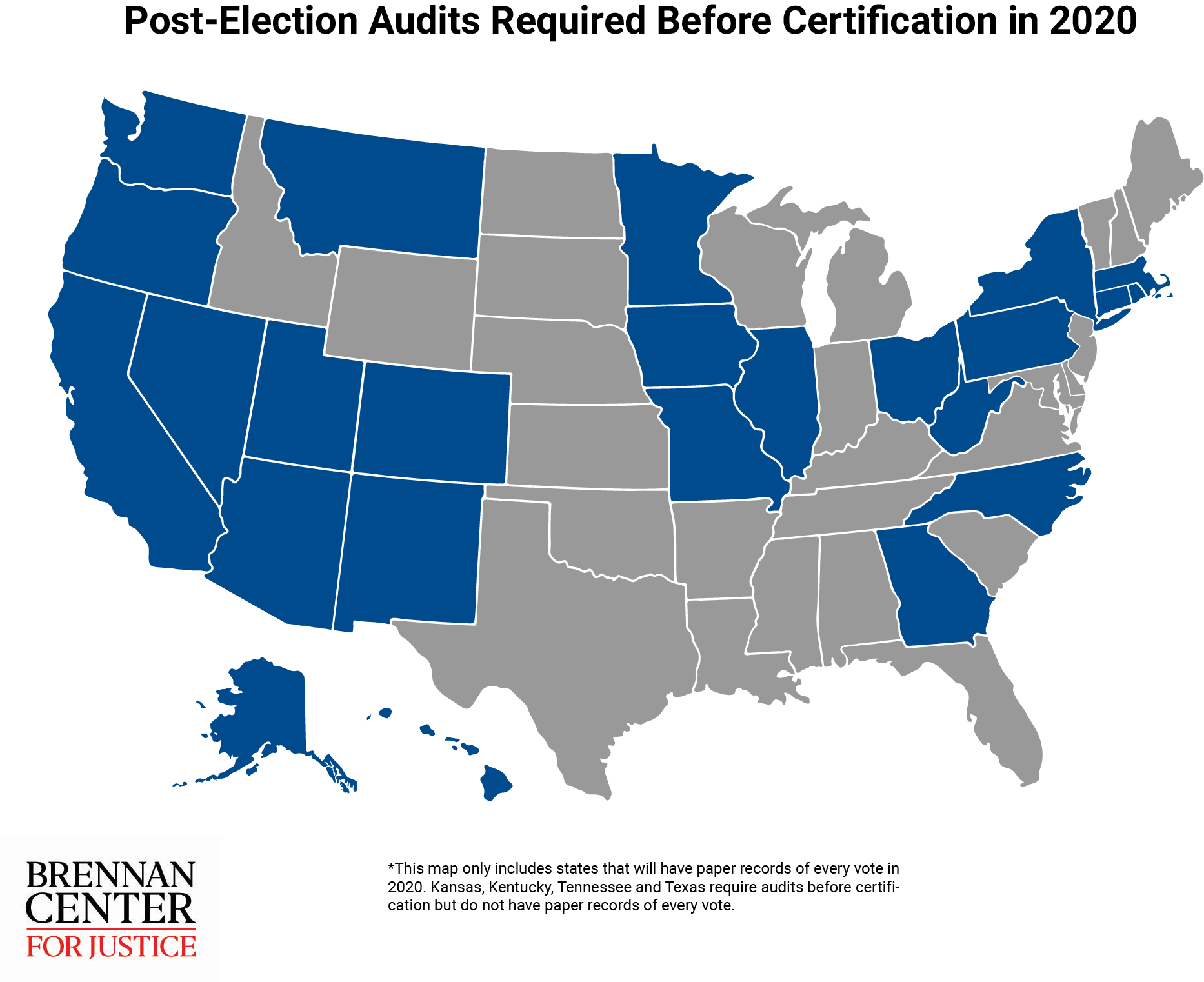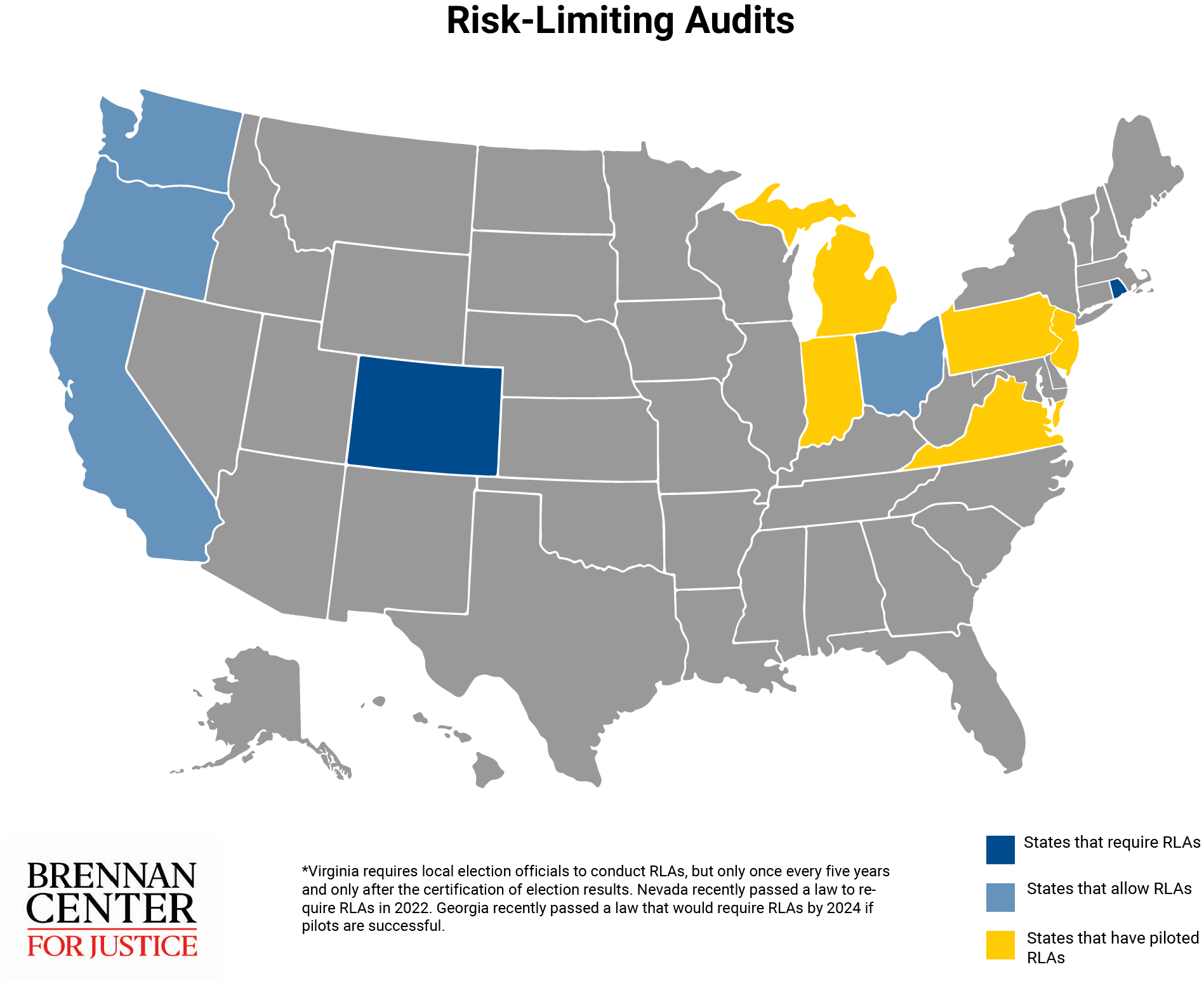Voting Machine Security: Where We Stand Six Months Before the New Hampshire Primary
While there has been substantial progress in securing voting machines since 2016, there is still more to do ahead of 2020.

In late July, the Senate Select Committee on Intelligence released its report on the Russian government’s attacks on America’s election infrastructure.[1] While the report offered dozens of recommendations related to vast and varied election systems in the United States (from voter registration databases to election night reporting), it pointedly noted that there was an urgent need to secure the nation’s voting systems in particular.[2] Among the two most important recommendations made were that states should (1) replace outdated and vulnerable voting systems with “at minimum… a voter-verified paper trail,” and (2) adopt statistically sound audits. These recommendations are not new and have been consistently made by experts since long before the 2016 election.[3]
Last year, Congress provided $380 million to states to help with upgrades, but it wasn’t enough. This analysis, six months ahead of the first primary for 2020, examines the significant progress we’ve made in these two areas since 2016, and it catalogs the important and necessary work that is left to be done.
I. Replacing Antiquated Voting Equipment
The lifespan of electronic voting machines can vary, but experts agree that systems over a decade old are more likely to need to be replaced for security and reliability reasons.[4] We estimate that in November 2018, 34 percent of all local election jurisdictions were using voting machines that were at least 10 years old as their primary polling place equipment (or as their primary tabulation equipment in all vote-by-mail jurisdictions).[5] This number includes counties and towns in 41 states.[6]
States, however, have made significant progress in replacing such machines since 2016. In 2017, Michigan began replacing its aging voting equipment statewide while Virginia decertified and replaced all paperless voting machines.[7] In 2018, Arkansas completed the replacement of its remaining antiquated paperless voting equipment.[8] In several other states, such as Colorado, Florida, and Nevada, significant replacement has happened at the local level since 2016.
These efforts are ongoing and expanding across the country in 2019, and several states are in route to having new voting machines in time for the 2020 elections. For instance, Ohio approved $114.5 million to replace aging voting machines ahead of the 2020 presidential election; California issued a requirement for counties to replace old voting machines by March of 2020; and North Dakota recently spent $11 million on new voting machines, which the secretary of state expects to be in place by the end of the year.[9]
Nearly Half of the States with Paperless Voting Machines in 2016 Will Have Replaced These Machines by the 2020 Elections
Action is also being taken to replace electronic voting machines that don’t produce a voter verifiable paper record in many of the states that still use them. Experts have long warned that these machines are a security risk because they do not allow election officials or the public to confirm electronic vote totals.[10] The Brennan Center estimates that compared to 2016, when approximately 27.5 million voters cast their ballots on paperless machines, a little over half, or as many as 16 million, will do so in 2020—though that number could go even lower with additional funding from Congress.[11] As the Brennan Center has previously found, many election officials would like to replace their equipment before 2020 but do not currently have the funds to do so.[12] A recent survey of election officials by Politico produced similar findings, noting that “many election officials have been slow to buy paper-based machines,” in part due “to a lack of money”.[13]
In 2016, 14 states used paperless voting machines as the primary polling place equipment in at least some of their counties and towns (Arkansas, Delaware, Georgia, Indiana, Kansas, Kentucky, Louisiana, New Jersey, Mississippi, South Carolina, Pennsylvania, Texas, Tennessee, and Virginia).[14]
Today, just 11 states use paperless machines as their primary polling place equipment in at least some counties and towns, as Virginia, Arkansas, and Delaware transitioned to paper-based voting equipment in 2017, 2018, and 2019, respectively.[15] In addition to these states, three more (Georgia, South Carolina, and Pennsylvania) have committed to replacing equipment by 2020. Consequently, we expect the number of states using paperless equipment as primary systems in at least some counties and towns will drop to no more than eight.[16]
Even so, a significant number of voters may not have a paper record of their vote in 2020. Using voter registration and turnout data from the 2016 and 2018 Election Administration and Voting Survey and 2018 voting equipment data from Verified Voting, we estimate that as many as 12 percent of voters (approximately 16 million voters) will vote on paperless equipment in November 2020. This compares to 20 percent of voters (27.5 million) in 2016.[17]
In its July report, the Senate intelligence committee noted that “paper ballots and optical scanners are the least vulnerable to cyber-attack.”[18] The vast majority of jurisdictions with voter verifiable paper records use such systems. But a minority of jurisdictions in 2020 will use Direct-Recording Electronic (DRE) machines with voter verifiable paper trails (VVPTs) or Ballot-Marking Devices (BMDs) as their primary polling place voting equipment. Approximately 6 percent of registered voters live in jurisdictions where the primary polling place equipment will be DREs with VVPTs and around 7.5 percent live in jurisdictions where the primary polling place equipment will be BMDs.[19]
These devices collect the voter’s choices and either produce a ballot that is then scanned by the voter in a separate scanner (BMDs) or create a “paper trail” that is preserved for potential review later. Experts have warned that some of these paper trails or ballots can be difficult to review.[20] Before purchasing such systems, election officials should consider how easy it will be for voters to review and understand the machine marked ballots. In jurisdictions where either system is used, election officials should put in place procedures that make it more likely voters will review and catch errors on the paper record, as well as consider additional security measures recommended by experts.[21]

II. Progress on Post-Election Audits
Paper-based systems provide better security because they create a paper record that voters can review before casting their ballot. Election officials can review these records during an audit after the election. However, these paper records will be of little security value unless they are used to check and confirm electronic tallies.
Traditional post-election audits, which generally require manual inspection of paper ballots cast in randomly selected precincts or on randomly selected voting machines, can provide assurance that individual voting machines accurately tabulated votes. Multiple states have employed these audits for over a decade. Currently, 22 states and the District of Columbia have voter verifiable paper records for all votes cast and require post-election audits of those paper records before certifying election results.[22]
This number should go up to at least 24 states by the November 2020 elections, after Pennsylvania and Georgia fully transition to paper-based equipment.[23] In total, these 24 states and the District of Columbia make up 295 electoral votes. The remaining 26 states, totaling 243 electoral votes, do not currently require post-election audits of all votes prior to certification. However, there is nothing stopping most of these remaining states from conducting such audits if they have the resources and will to do so.

A New “Gold Standard”: Risk-Limiting Audits
Risk-limiting audits are a comparatively new procedure and offer two important improvements to traditional audits. They are generally more efficient, requiring a review of a smaller number of ballots during the audit process. And the statistical modeling used is designed to detect potential inaccuracies in election outcomes, whether they are the result of accidental or intentional interference. RLAs can provide assurance that the reported winner did, in fact, win the election, instead of a traditional audit, which only assures officials that machines are working correctly. [24] Because of these features, the Brennan Center and many other experts have urged broad adoption of RLAs.
States have embraced RLAs at a rapid rate: Colorado was the first state to implement RLAs in 2017.[25] Not even two years later, more than 12 states are experimenting with the procedure in some fashion.
Currently, Colorado and Rhode Island require RLAs immediately after an election before results are legally certified; Nevada will do the same starting in 2022, thanks to recently passed legislation.[26] (Local election officials in Virginia are also required to use the procedure, but only once every five years and only after certification.)[27] Washington and Ohio allow election officials to select RLAs from a set of post-election audit options; California enacted a similar law last year that will apply for most of 2020.[28]
Election officials in a slew of these and other states — such as Alabama, Georgia, Indiana, Michigan, Missouri, New Jersey, Pennsylvania, and Virginia — have either already launched RLA pilots or plan to do so moving forward.[29] Michigan plans to conduct its first state-wide RLA pilot during the March 10 presidential primary, marking the first time that RLAs will be used in conjunction with the presidential election process in Michigan.[30]
Meanwhile, state legislatures continue to explore the proposal: a bill authorizing RLAs recently passed the Oregon state legislature, and lawmakers are considering RLA-related legislation in New Jersey, Ohio, and South Carolina.[31] Although some states were able to use the $380 million from 2018 to pilot RLAs, many states had other urgent needs, such as replacing aging voting machines and registration databases, and have not yet been able to.[32]

Conclusion
While there has been substantial progress in securing voting machines since 2016, there is still more to do ahead of 2020. As both the Senate Select Committee on Intelligence and National Academy of Sciences have noted, we should replace antiquated equipment, and paperless equipment in particular, as soon as possible.[33] Moreover, of the 42 states that should have paper records of every vote by 2020, 17 are not currently required to conduct post-election audits pre-certification.[34] And as the Brennan Center and other organizations have noted in Defending Elections, election security goes far beyond securing voting machines. In addition to the items discussed in this analysis, states and counties need more resources for items like cybersecurity support for local election jurisdictions, and upgrades to voter registration databases and other critical election systems.[35]
With research and writing support from William Dobbs-Allsopp.
Credit:Getty/Shutterstock/BCJ
[1] Report of the Select Committee on Intelligence United States Senate on Russian Active Measures Campaigns and Interference in the 2016 U.S. Election Volume 1: Russian Efforts Against Election Infrastructure with Additional Views, U.S. Senate Select Committee on Intelligence, July 15, 2019, https://www.intelligence.senate.gov/sites/default/files/documents/Report_Volume1.pdf.
[2] Ibid, 58.
[3] See e.g., Lawrence Norden, The Machinery of Democracy: Voting System Security, Accessibility, Usability, and Cost, Brennan Center for Justice, 2006, https://www.brennancenter.org/publication/machinery-democracy; Lawrence Norden, Aaron Burstein, Margaret Chen, and Joseph Lorenzo Hall, Post-Election Audits: Restoring Trust in Elections, Brennan Center for Justice, 2007, https://www.brennancenter.org/publication/post-election-audits-restoring-trust-elections-executive-summary.
[4] In 2015, the Brennan Center interviewed experts, such as Merle King (Executive Director at the Center for Election Systems at Kennesaw State University), Doug Jones (Professor of Computer Science at the University of Iowa), Daniel Lopresti (Professor of Computer Science at Lehigh University), and Rokey Suleman (former Executive Director of the D.C. Board of Elections and Ethics), who agreed with this assertion. See Lawrence Norden and Christopher Famighetti, America’s Voting Machines at Risk, Brennan Center for Justice, 2015, https://www.brennancenter.org/sites/default/files/publications/Americas_Voting_Machines_At_Risk.pdf.
[5] To arrive to this estimate, we analyzed biennial voting equipment data provided by Verified Voting from 2006-2018. We make the following assumptions: In non-vote-by-mail jurisdictions, we keep only polling place equipment. In jurisdictions with multiple machines, we exclude accessible machines. In all vote-by-mail jurisdictions, we keep absentee ballot machines. If multiple machines in a given jurisdiction meet the above requirements, we report the first year in which the oldest machine appears in the data. We exclude jurisdictions that only hand counted paper ballots in 2018. See “The Verifier — Polling Place Equipment — November 2018,” Verified Voting, accessed August 2019, https://www.verifiedvoting.org/verifier/.
[6] These 41 states are Alabama, Alaska, Arizona, Arkansas, California, Colorado, Connecticut, Delaware, Florida, Georgia, Hawaii, Illinois, Indiana, Iowa, Kansas, Kentucky, Louisiana, Massachusetts, Minnesota, Mississippi, Missouri, Montana, Nebraska, New Hampshire, New Jersey, North Carolina, North Dakota, Ohio, Oregon, Pennsylvania, South Carolina, South Dakota, Tennessee, Texas, Utah, Vermont, Virginia, Washington, West Virginia, Wisconsin, and Wyoming.
[7] Kathleen Gray, “New voting machines coming to Michigan: Here's how they're different,” Detroit Free Press, August 2, 2017, https://www.freep.com/story/news/2017/08/02/voting-machines-primary-election-michigan/532782001/; Laura Vozzella, “Virginia scraps touch-screen voting machines as election for governor looms,” The Washington Post, September 8, 2017, https://www.washingtonpost.com/local/virginia-politics/virginia-scraps-touch-screen-voting-machines-as-election-for-governor-looms/2017/09/08/e266ead6-94fe-11e7-89fa-bb822a46da5b_story.html?utm_term=.aef3881243f2.
[8] Chris Powell (Web Development, Research & Press Manager in the Communications and Education Division of the Arkansas Secretary of State), phone call with Liz Howard, February 25, 2019.
[9] “Ohio: $104.5M available for new voting equipment,” Associated Press, December 5, 2018, https://www.news-herald.com/news/elections/ohio-m-available-for-new-voting-equipment/article_fee6a5ae-324d-5338-bfc7-ce58fcda84e4.html; “Secretary of State Alex Padilla Sets Deadline for Counties to Retire Old Voting Machines and Modernize Election Infrastructure,” California Secretary of State Press Office, February 27, 2019, https://www.sos.ca.gov/administration/news-releases-and-advisories/2019/secretary-state-alex-padilla-sets-deadline-counties-retire-old-voting-machines-and-modernize-election-infrastructure/; Andrea Horn, “A look at North Dakota’s new $11 million election system,” KFYR-TV, July 16, 2019 https://www.kfyrtv.com/content/news/A-look-at-North-Dakotas-new-11-million-election-system-512810291.html.
[10] See e.g., America’s Voting Machines at Risk.
[11] The 2020 estimate assumes that eight states (Louisiana, New Jersey, Texas, Tennessee, Kentucky, Indiana, Kansas, and Mississippi) will still be using paperless machines as primary polling place equipment in at least some counties and towns in 2020. This is a high estimate of paperless machine use in 2020 because we do not account for the individual jurisdictions that have replaced their paperless equipment since November 2018 or that might replace their equipment by 2020 in these eight states due to lack of updated comprehensive data at the local level. To calculate how many voters voted on paperless machines in 2016, we (1) looked at the number of registered voters living in paperless jurisdictions in 2016, and (2) calculated the number of voters we estimate to have turned out to vote in person in paperless jurisdictions by relying on state level voter turnout rates and absentee (vote-by-mail) voting rates. To calculate how many voters will likely vote on paperless machines in 2020, we (1) looked at the number of registered voters living in paperless jurisdictions in 2018, (2) subtracted the voters living in states that have replaced paperless machines statewide since then (Delaware) or that we expect to replace paperless machines statewide by 2020 (Georgia, South Carolina and Pennsylvania), and (3) calculated the number of voters that we expect to turn out to vote in person in paperless jurisdictions in 2020 by relying on state level voter turnout rates and absentee (vote-by-mail) voting rates from 2016. We rely on voter registration and turnout data from the 2016 and 2018 Election Administration and Voting Survey and on 2016 and 2018 voting equipment data from Verified Voting. See Election Administration and Voting Survey: 2016 Comprehensive Report, U.S. Election Administration Commission, 2017, https://www.eac.gov/assets/1/6/2016_EAVS_Comprehensive_Report.pdf; Election Administration and Voting Survey: 2018 Comprehensive Report, U.S. Election Administration Commission, 2019, https://www.eac.gov/assets/1/6/2018_EAVS_Report.pdf; “The Verifier — Polling Place Equipment — November 2016,” Verified Voting, accessed August 2019, https://www.verifiedvoting.org/verifier/#year/2016/; “The Verifier — Polling Place Equipment — November 2018,” Verified Voting, accessed August 2019, https://www.verifiedvoting.org/verifier/#year/2018/.
[12] Lawrence Norden and Andrea Cordova, “Voting Machines at Risk: Where We Stand Today,” Brennan Center for Justice, March 5, 2019, https://www.brennancenter.org/analysis/voting-machines-risk-where-we-stand-today.
[13] Eric Geller, Beatrice Jin, Jordyn Hermani and Michael B. Farrell, “The scramble to secure America’s voting machines,” Politico, August 2, 2019, https://www.politico.com/interactives/2019/election-security-americas-voting-machines/index.html.
[14] In addition, two other states—Florida and Oklahoma— used and still use paperless machines as the accessible voting equipment in at least some jurisdictions. See “The Verifier — Polling Place Equipment — November 2018,” Verified Voting, accessed July, 2019, https://www.verifiedvoting.org/verifier/. The number of jurisdictions using paperless DREs has shrunk drastically in Florida, from 24 jurisdictions in 2016, to only four by November 2018. These four remaining counties are currently working to replace their paperless systems before the 2020 elections. See Eric Geller, Beatrice Jin, Jordyn Hermani and Michael B. Farrell, “The scramble to secure America’s voting machines,” Politico, August 2, 2019, https://www.politico.com/interactives/2019/election-security-americas-voting-machines/index.html. Oklahoma uses hybrid optical scan machines statewide. These machines tabulate verifiable paper ballots and, upon request of a voter with accessibility needs, provide additional functionality that results in a paperless ballot for these individual voters. When the tabulator is in accessibility mode, it creates a “cast vote record” (CVR), a digital record of the voter’s selections. These CVRs are printed after the polls close and are retained with the verifiable paper ballots cast at the polls.
[15] Laura Vozzella, “Virginia scraps touch-screen voting machines as election for governor looms,” The Washington Post, September 8, 2017, https://www.washingtonpost.com/local/virginia-politics/virginia-scraps-touch-screen-voting-machines-as-election-for-governor-looms/2017/09/08/e266ead6-94fe-11e7-89fa-bb822a46da5b_story.html?utm_term=.aef3881243f2; Chris Powell (Web Development, Research & Press Manager in the Communications and Education Division of the Arkansas Secretary of State), phone call with Liz Howard, February 25, 2019; Amy Cherry, “Delawareans to get 1st look at new voting machines in upcoming school board elections,” WDEL, May 6, 2019, https://www.wdel.com/news/video-delawareans-to-get-st-look-at-new-voting-machines/article_7d625346-6ddd-11e9-a2c7-4f6dfafa74af.html.
[16] Maggie Miller, “Georgia awards contract for new voting machines,” The Hill, July 29, 2019, https://thehill.com/policy/cybersecurity/455211-georgia-awards-contract-for-new-voting-machines; Tom Barton, “Company that courted SC elections chief wins $51M bid for new voting machines,” The State, June 10, 2019, https://amp.thestate.com/news/politics-government/article231392753.html; Confirmation hearing to consider the nomination of Kathy Boockvar as the Secretary of the Commonwealth, Senate State Government Committee, Pennsylvania (June 4, 2019) (Statement of Kathy Boockvar, Secretary of the Commonwealth), see https://www.senatorfolmer.com/2019/05/31/060419/.
[17] See footnote 11 for an explanation of our assumptions and methodology.
[18] Report of the Select Committee on Intelligence United States Senate on Russian Active Measures Campaigns and Interference in the 2016 U.S. Election Volume 1, 58.
[19] This is a high estimate of BMD use. Half of the jurisdictions we identified using BMDs as primary polling place equipment in 2020 will be using Dominion Image Cast Evolution machines, which are hybrid machines that can function as optical scanners to hand marked paper ballots. To arrive to these estimates, we rely on data on registered voters from the 2018 Election Administration and Voting Survey and 2018 voting equipment data from Verified Voting.
[20] Stephen N. Goggin and Michael D. Byrne, “An examination of the auditability of voter verified paper audit trail (VVPAT) ballots.” Paper presented at the Proceedings of the USENIX Workshop on Accurate Electronic Voting Technology, Boston, MA, 2007, http://trackback.cs.rice.edu/wp-content/uploads/2007/08/evt07-goggin.pdf;
[21] See e.g., Dan S. Wallach, “On the security of ballot marking devices.” arXiv:1908.01897v1, Cornell University, NY, August 5, 2019, https://arxiv.org/pdf/1908.01897.pdf.
[22] For the purposes of this report, the Brennan Center only counted jurisdictions that (1) mandate post-election audits of (2) voter-verified paper records (3) before the certification of election results. These twenty-two states are Alaska, Arizona, California, Colorado, Connecticut, Hawaii, Illinois, Iowa, Massachusetts, Minnesota, Missouri, Montana, Nevada, New Mexico, New York, North Carolina, Ohio, Oregon, Rhode Island, Utah, Washington, and West Virginia. Although Ohio conducts post-election audits after certification, the Election Board must amend its certification if the audit results in a change of the vote totals reported in the official canvass. Post-election audits in Illinois, Iowa are not legally binding on election results, while statutes in California, Colorado, Connecticut, Hawaii, Nevada and Utah offer no guidance on whether audits are binding. Other states, which only require post-election audits for jurisdictions that use paper-based equipment (Kansas, Kentucky, Tennessee and Texas) were not included in the list since they still have some jurisdictions using paperless equipment. New Jersey’s post-election statute is dependent on the implementation of new voting systems that produce voter verifiable paper records (which have not yet been purchased); See “POST-ELECTION AUDITS,” National Conference of State Legislatures, last modified February, 1, 2019, accessed Jun 29, 2019, http://www.ncsl.org/research/elections-and-campaigns/post-election-audits635926066.aspx; “State Audit Laws Searchable Database,” Verified Voting, accessed July 2, 2019, https://www.verifiedvoting.org/state-audit-laws/; Danielle Root, Liz Kennedy, Michael Sozan, and Jerry Parshall, Election Security in All 50 States: Defending America’s Elections, Center for American Progress, February 12, 2018, https://www.americanprogress.org/issues/democracy/reports/2018/02/12/446336/election-security-50-states/.
[23] Pennsylvania, which requires traditional post-election audits before certification in jurisdictions with paper-based equipment, is expected to have replaced all its remaining paperless equipment by the 2020 elections. Georgia recently passed a law requiring pre-certification audits of paper ballots by November 2020. See H.B. 316, 2019 Leg., Reg, Sess. (Ga. 2019) (enacted April 4, 2019).
[24] Assuming the reported winner did, in fact, win the election. See Jerome Lovato, Risk-Limiting Audits – Practical Application, U.S. Election Assistance Commission, June 25, 2018, https://www.eac.gov/assets/1/6/Risk-Limiting_Audits_-_Practical_Application_Jerome_Lovato.pdf.
[25] Ann Marie Awad, “Colorado Launches First in the Nation Post-Election Audits,” NPR, November 22, 2017, https://www.npr.org/2017/11/22/566039611/colorado-launches-first-in-the-nation-post-election-audits.
[26] Colo. Rev. Stat. Ann. § 1-7-515; 17 R.I. Gen. Laws Ann. § 17-19-37.4(b); The Nevada law requires the state to pilot RLAs during the 2020 election. S.B. 123, 2019 Leg., Reg. Sess. (Nev. 2019).
[27] Va. Code Ann. § 24.2-671.1.
[28] Wash. Rev. Code Ann. §29A.60.185; Ohio Election Official Manual, Ohio Secretary of State, August 1, 2018, https://www.sos.state.oh.us/globalassets/elections/directives/2017/dir2017-10_eom.pdf/; The California law authorizes RLAs starting with the March 3, 2020 primary and automatically sunsets at the end of 2020. Cal. Elec. Code § 15367.
[29] A pilot is an opportunity for jurisdictions to try their hand at RLAs in order to evaluate their feasibility. Clay Helms (Director of Elections, Alabama), interview with the Brennan Center for Justice, June 2019; Ga. Code Ann. § 21-2-498; P.L.34-2019 (Ind. 2019); Kellie Ottoboni, “Piloting Risk-Limiting Audits in Michigan,” Berkeley Institute for Data Science, December 20, 2018, https://bids.berkeley.edu/news/piloting-risk-limiting-audits-michigan; Shane Shoeller, (County Clerk, Greenville, Missouri), interview with the Brennan Center for Justice, June 10, 2019; Secretary Way, State Election Officials Take Part in Pilot Risk-Limiting Audit, Department of State, New Jersey, March 8, 2019, https://nj.gov/state/press-2019-0308.shtml; “Philadelphia and Mercer to Implement New Post-Election Audits for November 2019 Election,” Pennsylvania Pressroom, February 27, 2019, https://www.media.pa.gov/Pages/State-details.aspx?newsid=322#; City of Fairfax, Post-Election, Risk-Limiting Audit Pilot, Department of Elections, Virginia, September 20, 2018, https://www.elections.virginia.gov/media/formswarehouse/maintenance-reports/2018FairfaxPostElectionRLA.pdf.
[30] Ginny Vander Roest (Training and Communications Manager, Michigan Bureau of Elections), interview with the Brennan Center for Justice, July 1, 2019.
[31] S.B. 944, 2019 Leg., Reg. Sess. (Ore. 2019); A.B. 3991, 218th Leg., (N.J. 2018); S.B. 52, 133rd Gen. Assemb. (Ohio 2019); H.B 3304, 2019 Gen. Assemb. 123rd Sess. (S.C. 2019).
[32] Christopher Deluzio, Liz Howard, Paul Rosenzweig, David Salvo, and Rachael Dean Wilson, Defending Elections: Federal Funding Needs for State Election Security, University of Pittsburgh Institute for Cyber Law, Policy, and Security, Brennan Center for Justice, R Street Institute, Alliance for Securing Democracy, July 18, 2019, https://www.brennancenter.org/sites/default/files/publications/2019_07_EACFunding%20Report_FINAL.pdf.
[33] Report of the Select Committee on Intelligence United States Senate on Russian Active Measures Campaigns and Interference in the 2016 U.S. Election Volume 1, 59; Securing the Vote: Protecting American Democracy, The National Academies of Sciences, Engineering, and Medicine, 2018, 5, https://www.nap.edu/read/25120/chapter/1.
[34] These 17 states are Alabama, Arkansas, Delaware, Florida, Idaho, Maine, Maryland, Michigan, Nebraska, New Hampshire, North Dakota, Oklahoma, South Dakota, Vermont, Virginia, Wisconsin and Wyoming.
[35] Deluzio, Howard, Rosenzweig, Salvo, and Dean Wilson, Defending Elections: Federal Funding Needs for State Election Security.





